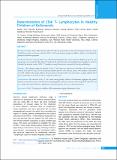Please use this identifier to cite or link to this item:
https://hdl.handle.net/20.500.14356/1568| Title: | Determination of CD4+ T- Lymphocytes in Healthy Children of Kathmandu |
| Authors: | Karn, Sapana Bhattarai, Manjula Rauniyar, Ramanuj Adhikari, Anurag Karna, Pratik Upadhyay, Bishnu Prasad gupta, Birendra prasad |
| Citation: | KarnS., BhattaraiM., RauniyarR., AdhikariA., KarnaP., UpadhyayB. P., & guptaB. prasad. (2018). Determination of CD4+ T- Lymphocytes in Healthy Children of Kathmandu. Journal of Nepal Health Research Council, 16(3), 325-329. https://doi.org/10.33314/jnhrc.v16i3.1068 |
| Issue Date: | 2018 |
| Publisher: | Nepal Health Research Council |
| Article Type: | Original Article |
| Keywords: | CD4+ T lymphocyte Children HIV Immunophenotyping Kathmandu Nepal |
| Series/Report no.: | Jul-Sep 2018;1068 |
| Abstract: | Abstract Background: The cluster differentiation (CD) of T-cell is the good marker for the immunological competence study. Nepal does not have a reference value for CD4+ T cell count and percentage for children, which severely limits the prospect of pediatric prognosis. Methods: This cross-sectional study was conducted in Kathmandu valley where total 207 children of age 0-14 year age group were recruited in this study. We analyzed 50 cord blood and 157 peripheral blood samples in order to calculate the absolute count of CD4+ T lymphocyte using Fluorescence-activated cell sorting methodology. Results: The reference range for absolute CD4+ T cell count was found to be 634-4040 cells/µL(mean1470; median: 1335 and 95% CI [1322-1617]) for male children and 491-2922 cells/µL (mean: 1443 median: 1326 and95% CI [1298-1588]) for the female children.We also observed elevated CD4 to the CD3 ratio in younger children (0.67 from cord blood Vs 0.53 from 10-14yr) compared to older ones. Conclusions: The observed CD4+ T cell counts among healthy children of Kathmandu highlights the gender differences skewed for male as well the need of defining specific reference values for other lymphocyte subsets as well in a country like Nepal which has a population with diverse genetic and socio-cultural parameters. Keywords: CD4+ T lymphocyte; children; HIV; immunophenotyping; Kathmandu; Nepal. |
| Description: | Original Article |
| URI: | http://103.69.126.140:8080/handle/20.500.14356/1568 |
| ISSN: | Print ISSN: 1727-5482; Online ISSN: 1999-6217 |
| Appears in Collections: | Vol. 16 No. 3 Issue 40 Jul - Sep 2018 |
Files in This Item:
| File | Description | Size | Format | |
|---|---|---|---|---|
| 1068-Manuscript-6665-1-10-20181030.pdf | Fulltext Article. | 317.76 kB | Adobe PDF |  View/Open |
Items in DSpace are protected by copyright, with all rights reserved, unless otherwise indicated.
